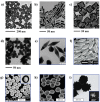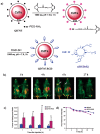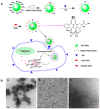Encapsulation for Cancer Therapy
- PMID: 32244513
- PMCID: PMC7180689
- DOI: 10.3390/molecules25071605
Encapsulation for Cancer Therapy
Abstract
The current rapid advancement of numerous nanotechnology tools is being employed in treatment of many terminal diseases such as cancer. Nanocapsules (NCs) containing an anti-cancer drug offer a very promising alternative to conventional treatments, mostly due to their targeted delivery and precise action, and thereby they can be used in distinct applications: as biosensors or in medical imaging, allowing for cancer detection as well as agents/carriers in targeted drug delivery. The possibility of using different systems-inorganic nanoparticles, dendrimers, proteins, polymeric micelles, liposomes, carbon nanotubes (CNTs), quantum dots (QDs), biopolymeric nanoparticles and their combinations-offers multiple benefits to early cancer detection as well as controlled drug delivery to specific locations. This review focused on the key and recent progress in the encapsulation of anticancer drugs that include methods of preparation, drug loading and drug release mechanism on the presented nanosystems. Furthermore, the future directions in applications of various nanoparticles are highlighted.
Keywords: anticancer therapy; biocompatibility; biodegradability; bioimaging; cancer; drug delivery system; nanocapsules (NCs); nanomedicine; nanoparticles; nanotechnology.
Conflict of interest statement
The authors declare no conflict of interest.
Figures
















Similar articles
-
Advanced targeted therapies in cancer: Drug nanocarriers, the future of chemotherapy.Eur J Pharm Biopharm. 2015 Jun;93:52-79. doi: 10.1016/j.ejpb.2015.03.018. Epub 2015 Mar 23. Eur J Pharm Biopharm. 2015. PMID: 25813885 Review.
-
Nanocarriers for anticancer drugs--new trends in nanomedicine.Curr Drug Metab. 2013 Jun;14(5):547-64. doi: 10.2174/1389200211314050005. Curr Drug Metab. 2013. PMID: 23687925 Review.
-
Nanotechnology based targeted drug delivery.Annu Int Conf IEEE Eng Med Biol Soc. 2010;2010:3731-2. doi: 10.1109/IEMBS.2010.5627506. Annu Int Conf IEEE Eng Med Biol Soc. 2010. PMID: 21096863
-
Advantages and limitations of nanostructures for biomedical applications.Adv Clin Exp Med. 2025 Mar;34(3):447-456. doi: 10.17219/acem/186846. Adv Clin Exp Med. 2025. PMID: 38860712 Review.
-
Applications of Nanomedicine in Brain Tumor Therapy: Nanocarrierbased Drug Delivery Platforms, Challenges, and Perspectives.Recent Pat Nanotechnol. 2025;19(1):99-119. doi: 10.2174/0118722105244482231017102857. Recent Pat Nanotechnol. 2025. PMID: 37937554 Review.
Cited by
-
Polyelectrolyte Microcapsule-Assembled Colloidosomes: A Novel Strategy for the Encapsulation of Hydrophobic Substances.Polymers (Basel). 2025 Jul 18;17(14):1975. doi: 10.3390/polym17141975. Polymers (Basel). 2025. PMID: 40732853 Free PMC article.
-
Nanomedicine strategies to target coronavirus.Nano Today. 2020 Dec;35:100961. doi: 10.1016/j.nantod.2020.100961. Epub 2020 Aug 31. Nano Today. 2020. PMID: 32904707 Free PMC article. Review.
-
Environmentally Friendly Strategies for Formulating Vegetable Oil-Based Nanoparticles for Anticancer Medicine.Pharmaceutics. 2023 Jul 8;15(7):1908. doi: 10.3390/pharmaceutics15071908. Pharmaceutics. 2023. PMID: 37514094 Free PMC article. Review.
-
In Vitro Assessment of Poly-N-Vinylpyrrolidone/Acrylic Acid Nanoparticles Biocompatibility in a Microvascular Endothelium Model.Int J Mol Sci. 2022 Oct 18;23(20):12446. doi: 10.3390/ijms232012446. Int J Mol Sci. 2022. PMID: 36293301 Free PMC article.
-
Innovative theranostic hydrogels for targeted gastrointestinal cancer treatment.J Transl Med. 2024 Oct 27;22(1):970. doi: 10.1186/s12967-024-05749-9. J Transl Med. 2024. PMID: 39465365 Free PMC article. Review.
References
-
- Wiwanitkit V. Cancer nanotherapy: Concept for design of new drug. J. Med. Hypotheses Ideas. 2013;7:3–4. doi: 10.1016/j.jmhi.2012.10.002. - DOI
-
- Costa J. Cancer. [(accessed on 2 January 2020)]; Available online: https://www.britannica.com/science/cancer-disease.
-
- Afshar M., Madani S., Tarazoj A.A., Papi S.H., Otroshi O., Gandomani H.S., Rahimi A., Salehiniya H. Physical Activity and Types of Cancer. WCRJ. 2018;5:1–11.
-
- International Agency for Research on Cancer . World Cancer Report 2014. IARC; Lyon, France: 2014.
Publication types
MeSH terms
Substances
Grants and funding
LinkOut - more resources
Full Text Sources

